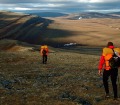Running barefoot or donning minimalist shoes is a concept steeped in history. In 1960, Abebe Bikila famously clinched the marathon gold medal in Rome sans shoes. Nevertheless, presuming that barefoot running is universally beneficial for all runners would be a substantial fallacy.
What Constitutes Barefoot Running?
Barefoot shoes, often referred to as minimalist or minimal shoes, are meticulously crafted to emulate the sensation of running without footwear.
These shoes strive to deliver an experience that mirrors natural foot movement. They empower the feet to move with greater freedom and flexibility, akin to the barefoot condition.
Customarily, barefoot shoes are equipped with a thin and pliable sole, facilitating a more natural adaptation to the terrain. Additionally, they frequently feature a broader toe box, allowing the toes to spread and grip more effectively.
The quintessential objective of minimalist shoes is to foster a more natural gait and posture while fortifying the muscles in the feet and legs.
The Foot’s Natural Running Capabilities
The human foot is inherently endowed with remarkable shock-absorbing properties. Comprising 28 bones, 33 joints, and over 100 tendons, it is adeptly designed to accommodate motion. The articulation of foot joints constitutes the most effective cushioning system for the knees.
Consequently, an insole tailored to the individual’s foot should, except in rare instances, possess a degree of flexibility, contingent upon the foot’s geometry, the runner’s weight, and their running technique.
Insoles that are excessively rigid impede foot mobility and diminish the innate cushioning effect, escalating the risk of knee injuries.
Benefits of Minimalist Shoes
Minimalist shoes proffer a multitude of benefits, which I shall succinctly enumerate:
- Enhanced Posture: Barefoot shoes advocate a more natural posture during ambulation and running, potentially alleviating strain on the back and muscles.
- Muscle Reinforcement: They enable the feet to manoeuvre more freely, thereby strengthening the musculature in the feet, legs, and core.
- Mitigation of Injuries: By endorsing a natural gait and improved posture, barefoot shoes can curtail the incidence of injuries such as sprains and muscle strains.
- Toe Alignment: A more spacious toe box permits natural toe splay, averting issues like bunions and hammer toes.
- Augmented Mobility and Flexibility: These shoes enhance the dexterity and suppleness of the feet and joints.
- Enhanced Balance and Proprioception: The tactile feedback from the ground improves balance and body coordination.
It is imperative to transition to barefoot shoes gradually, allowing the feet ample time to acclimate to the new running style. The benefits may vary based on individual anatomy and specific needs.
Considerations Before Embracing Barefoot or Minimalist Shoes
Despite the myriad advantages of running barefoot or with minimalist shoes, several factors warrant consideration.
From early childhood, we are accustomed to shoes with a heel elevation of approximately 1.5-2 cm for men and 2-5 cm for women. This heel height conditions our posterior muscle chain (Achilles tendon, calf muscles, hamstrings) to a shortened state commensurate with the heel height of both casual and athletic footwear.
Therefore, it is inadvisable to abruptly switch from running shoes with a 2-3 cm heel to flat barefoot shoes. Our tendons and muscles necessitate a period of adaptation to the new scenario to prevent injuries. Gradual reduction of heel height is the optimal strategy to acclimate the body to the new running style.
Another critical factor is the foot’s adaptation to shoe cushioning. Excessive cushioning can impede bone development and reduce stability. Hence, we do not advocate commencing barefoot shoe running on hard surfaces like asphalt. Instead, initiate on softer terrains such as grass, forest trails, or sand.
Who Are Minimalist Shoes Suitable For?
Runners exhibiting limited range of motion in their foot joints or other pathological gait patterns should employ custom insoles and appropriate footwear to avert injuries. Custom insoles and specifically designed shoes are indispensable for these runners.
Conclusion
The human foot is naturally equipped for barefoot running, especially on soft, shock-absorbing surfaces. However, barefoot running or minimalist shoes are not universally suitable for all runners. Only those without significant misalignments and possessing adequate muscular and ligamentous elasticity should contemplate transitioning to barefoot shoes. A gradual adjustment is essential in this process.











